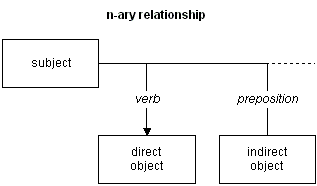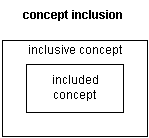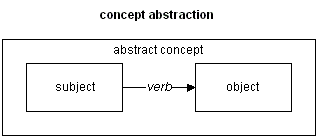A Natural Conceptual Modeling Language
Nik Boyd
Copyright 1998 Nikolas S. Boyd. Permission is granted to copy this
document provided this copyright statement is retained in all copies.
The role of graphical conceptual models is similar to that played by
object models - they allow one to grasp several concepts and the relationships
between them at a glance. So, while such pictures are not exactly worth "a
thousand words," they do help one to visualize (sometimes complex)
relationships between concepts that might otherwise be difficult to integrate
and understand from a purely textual description.
There are several elaborate graphical notations that could be used for
conceptual modeling, ranging from those used in the past for conceptual graphs
[Sowa 1982] to those presently used for object
modeling [UML 1997]. However, if lay people cannot
readily understand the graphical models we produce, they cannot validate
whether our models are correct. So, this paper introduces a new graphical
language for building conceptual models.
Natural Conceptual Modeling Language (NCML) was intentionally kept very
simple, addressing only the primary syntactic elements of natural languages -
nouns, verbs and the prepositions associated with verbs. Because of its
relative syntactic transparency, NCML can be used to closely represent the
semantics of simple sentences from any natural language that contains nouns and
verbs.
The elements of NCML are labeled rectangles and labeled arrows and
lines. Labeled rectangles represent sentence subjects and objects. Labeled
arrows represent verbs and labeled lines represent prepositions that contribute
to the predicates of the verbs. This notation serves as a reminder of the
metaphoric relationship between natural language and the object-oriented
paradigm - the sentence subject (or an object) may later become the receiver of
an object-oriented message.
 The elements
of NCML may be combined to create graphical models that represent simple
sentences. The most frequent kind of English sentence has a simple structure -
subject verb object (SVO). This kind of sentence identifies a binary
relationship - i.e., a relationship between two nouns - the subject and the
object.
The elements
of NCML may be combined to create graphical models that represent simple
sentences. The most frequent kind of English sentence has a simple structure -
subject verb object (SVO). This kind of sentence identifies a binary
relationship - i.e., a relationship between two nouns - the subject and the
object.
 English
sentences can also express complex relationships between a subject and multiple
objects. Such sentences identify n-ary relationships - e.g., relationships
between three (ternary), four (quaternary), or more parts. This kind of
sentence contains one or more prepositions that contribute additional nouns to
the predicate of the verb. When the verb identifies an action initiated by the
sentence subject, the additional nouns may become the arguments of an
object-oriented message. When the verb identifies a static (often structural)
relationship between the subject and the objects, the nouns may become the
fields of a record in a relational table or the fields of another object -
i.e., when the verb can be transformed into a noun through nominalization.
English
sentences can also express complex relationships between a subject and multiple
objects. Such sentences identify n-ary relationships - e.g., relationships
between three (ternary), four (quaternary), or more parts. This kind of
sentence contains one or more prepositions that contribute additional nouns to
the predicate of the verb. When the verb identifies an action initiated by the
sentence subject, the additional nouns may become the arguments of an
object-oriented message. When the verb identifies a static (often structural)
relationship between the subject and the objects, the nouns may become the
fields of a record in a relational table or the fields of another object -
i.e., when the verb can be transformed into a noun through nominalization.
 Some ideas
include or subsume one or more parts. There are two kinds of hierarchical
organizations for such conceptual inclusion.
Some ideas
include or subsume one or more parts. There are two kinds of hierarchical
organizations for such conceptual inclusion.
- generalization-specialization hierarchies
- whole-part structural hierarchies
For the sake of notational simplicity, distinction between the kinds of
hierarchies are deferred until object-oriented analysis. So, both kinds of
inclusion are depicted using nested rectangles, where the rectangle(s) that
represent the included concept(s) are nested inside of the rectangle that
represents the inclusive concept.
 Another
kind of conceptual inclusion exists, namely abstraction. Some concepts can be
defined in terms of relationships between other concepts. Such abstraction can
be especially useful when breaking complex sentences down into simpler ones.
Some sentences contain complex combinations of dependent and independent
clauses, especially sentences that contain conditions that express invariants,
constraints, rules, etc. Abstraction provides a way of representing a
relationship or a complex set of relationships as a single concept. For
example, consider the following abstraction. Here, the verb "employs" has been
nominalized by the -ment suffix, producing the noun "employment." The
employment concept abstracts the relationship "employer employs
employee."
Another
kind of conceptual inclusion exists, namely abstraction. Some concepts can be
defined in terms of relationships between other concepts. Such abstraction can
be especially useful when breaking complex sentences down into simpler ones.
Some sentences contain complex combinations of dependent and independent
clauses, especially sentences that contain conditions that express invariants,
constraints, rules, etc. Abstraction provides a way of representing a
relationship or a complex set of relationships as a single concept. For
example, consider the following abstraction. Here, the verb "employs" has been
nominalized by the -ment suffix, producing the noun "employment." The
employment concept abstracts the relationship "employer employs
employee."

References
[Sowa, 1984] J. F. Sowa. Conceptual Structures: Information
Processing in Mind and Machine. Addison-Wesley, Reading, Massachusetts,
1984.
[UML, 1997] Grady Booch, Ivar Jacobson, James Rumbaugh. The Unified
Modeling Language. Rational
Software, 1997.
 The elements
of NCML may be combined to create graphical models that represent simple
sentences. The most frequent kind of English sentence has a simple structure -
subject verb object (SVO). This kind of sentence identifies a binary
relationship - i.e., a relationship between two nouns - the subject and the
object.
The elements
of NCML may be combined to create graphical models that represent simple
sentences. The most frequent kind of English sentence has a simple structure -
subject verb object (SVO). This kind of sentence identifies a binary
relationship - i.e., a relationship between two nouns - the subject and the
object. English
sentences can also express complex relationships between a subject and multiple
objects. Such sentences identify n-ary relationships - e.g., relationships
between three (ternary), four (quaternary), or more parts. This kind of
sentence contains one or more prepositions that contribute additional nouns to
the predicate of the verb. When the verb identifies an action initiated by the
sentence subject, the additional nouns may become the arguments of an
object-oriented message. When the verb identifies a static (often structural)
relationship between the subject and the objects, the nouns may become the
fields of a record in a relational table or the fields of another object -
i.e., when the verb can be transformed into a noun through nominalization.
English
sentences can also express complex relationships between a subject and multiple
objects. Such sentences identify n-ary relationships - e.g., relationships
between three (ternary), four (quaternary), or more parts. This kind of
sentence contains one or more prepositions that contribute additional nouns to
the predicate of the verb. When the verb identifies an action initiated by the
sentence subject, the additional nouns may become the arguments of an
object-oriented message. When the verb identifies a static (often structural)
relationship between the subject and the objects, the nouns may become the
fields of a record in a relational table or the fields of another object -
i.e., when the verb can be transformed into a noun through nominalization. Some ideas
include or subsume one or more parts. There are two kinds of hierarchical
organizations for such conceptual inclusion.
Some ideas
include or subsume one or more parts. There are two kinds of hierarchical
organizations for such conceptual inclusion. Another
kind of conceptual inclusion exists, namely abstraction. Some concepts can be
defined in terms of relationships between other concepts. Such abstraction can
be especially useful when breaking complex sentences down into simpler ones.
Some sentences contain complex combinations of dependent and independent
clauses, especially sentences that contain conditions that express invariants,
constraints, rules, etc. Abstraction provides a way of representing a
relationship or a complex set of relationships as a single concept. For
example, consider the following abstraction. Here, the verb "employs" has been
nominalized by the -ment suffix, producing the noun "employment." The
employment concept abstracts the relationship "employer employs
employee."
Another
kind of conceptual inclusion exists, namely abstraction. Some concepts can be
defined in terms of relationships between other concepts. Such abstraction can
be especially useful when breaking complex sentences down into simpler ones.
Some sentences contain complex combinations of dependent and independent
clauses, especially sentences that contain conditions that express invariants,
constraints, rules, etc. Abstraction provides a way of representing a
relationship or a complex set of relationships as a single concept. For
example, consider the following abstraction. Here, the verb "employs" has been
nominalized by the -ment suffix, producing the noun "employment." The
employment concept abstracts the relationship "employer employs
employee."